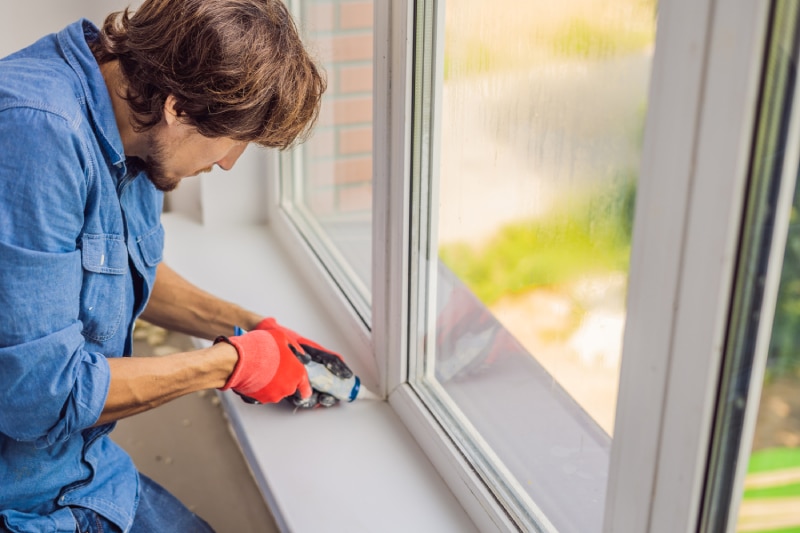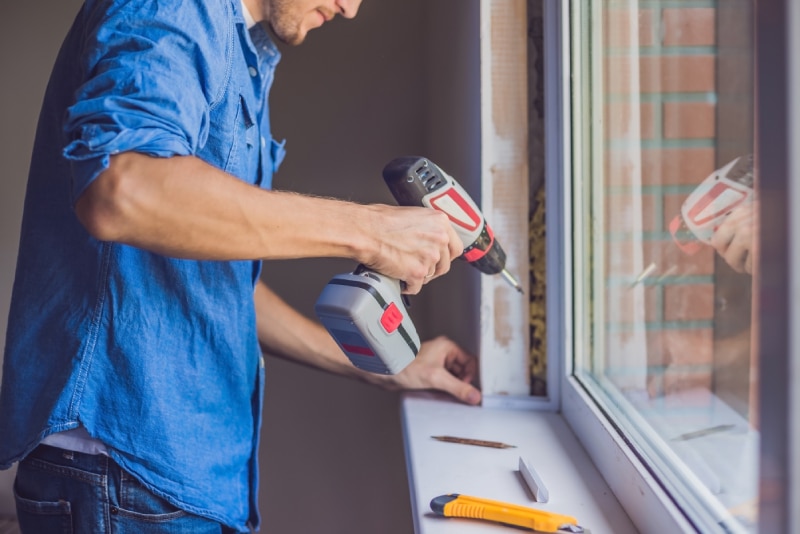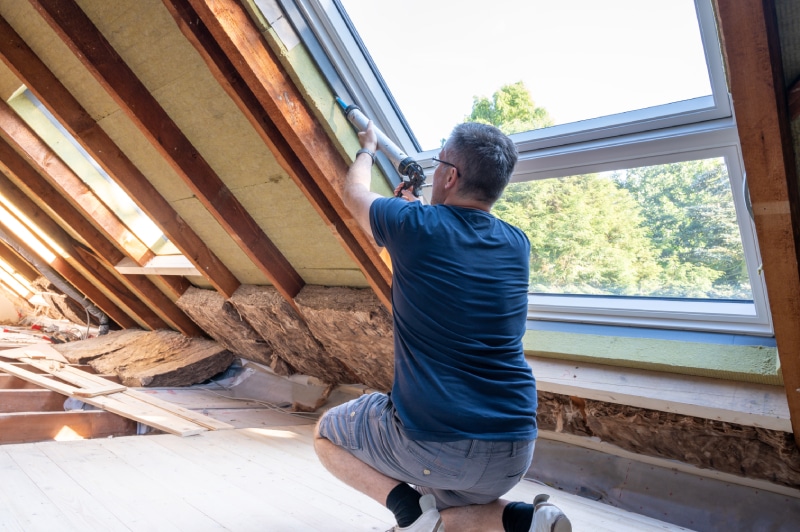At first glance, DIY replacement windows sound like a great idea. And you’re certainly not alone if you’re wondering, can I fix or replace my own windows? According to a recent study, approximately 71% of homeowners in the USA stated that inflation drove them to attempt a DIY home improvement project in the last couple years rather than calling in a professional.
With enough determination and know-how, you certainly can replace your own windows (after you purchase the right tools and materials). However, the more important question to ask is “Should I replace my own windows?”
For the average Joe, manhandling a fragile, expensive sheet of glass into place can be a gamble. Not to mention the delicacy with which you’ll need to treat your window frames and siding.
So before you bite off a bigger DIY project than you can chew, let’s take a look at the pros and cons of replacing your own windows. You’ll want to know exactly what you’re getting yourself into before you open up your wallet and head down to the hardware store.

The Pros of DIY Window Replacement
Despite the numerous risks, there are also a couple of benefits to installing your own windows.
You’ll spend less money on labor.
Lower labor costs are the number one reason homeowners turn to DIY. The math isn’t complex: if you DIY your home improvement project, you save 100% on hired labor. All it costs is your time and effort. That savings becomes even more enticing when it comes to larger home improvement projects—in those situations, you’re rarely hiring one person. Most contractors come with a crew that ranges from anywhere between two to ten people. That much paid labor adds up quickly.
You’ll get the satisfaction of a job well done.
Pride in your window installation may not seem like a significant pro, but the accomplishment means a lot to many homeowners. Not only does walking by a completed project fill you with that warm, self-sufficient glow, it also gives you a huge confidence boost when it comes to other handiwork.
After all, installing a simple A/C bracket doesn’t feel nearly as daunting after replacing an entire window.
The Cons of DIY Window Installation
Unfortunately, there are far more cons to DIY window installations than pros. That doesn’t mean you can’t jump in with a can-do attitude, it simply means you need to be extremely aware of the risks while doing so.
There’s always a risk of injury.
First off, when you DIY any major carpentry or home improvement project, you risk bodily harm. Window replacement comes with additional risks because of the potential for broken glass and exposure to lead paint or asbestos.
Lead paint and asbestos pose health risks if you don’t know how to approach them. If you’re looking to replace windows in a home built before 1978, there’s a high chance you might breathe in lead paint particles and develop complications without proper protection. Also check that your window putty does not contain asbestos—if it does, you’ll want professional assistance.
For safety’s sake, it’s best to leave it to the experts in these circumstances.
You’ll be fully responsible for costly mistakes.
When you replace a window, you’re not just replacing a window; you’re replacing a key part of the structure of your home. Unlike a botched paint job or uneven frame hanging, an improper window installation not only looks unpleasant, but it can cause significant damage to your house.
Windows are built into the walls and foundation of your home. When you replace a window, you’re exposing the structure to the elements and to potential damage from improperly used tools. If you accidentally damage something vital, that’s not an ‘oops’ moment: it’s thousands of dollars in repairs.
Additionally, if your window isn’t installed correctly, you up your risk for home invasion, extreme weather damage, and black mold.

You’ll have higher tools and materials costs.
Window replacement labor might cost more with a professional, but tools and materials cost far less since you won’t need to procure them yourself.
If you DIY your window replacement, you’re starting from scratch. That means you may need to run down to the hardware store and invest in hundreds of dollars of equipment just to start your project. When you hire a professional, you don’t pay for the cost of the tools they use—you only pay for one-use materials.
Depending on how handy you are around the house, you might already have a few tools lying around. That said, at minimum (and without the window itself) you need the following tools to attempt a DIY window installation:
- Hammer
- Level
- Tape measurer
- Pry bar (ideally small)
- Caulk gun
- Caulk
- Power drill
- Screwdriver
- Putty
- Putty knife
- Utility knife
- Tarp
Additionally, if you choose to go it alone, you might end up paying more for one-time use materials than with a professional contractor. Many contractors work in bulk and as a result, have access to deals on materials and windows that you can’t get as a single DIY-er.
You’ll be looking at a longer installation timeframe.
While expert window replacement is rarely a one-day process, DIY-ing your window replacement can take significantly longer than calling in the professionals. Not only do DIY jobs simply take longer to complete because of a lack of experience, you also have to factor in prep time.
You can’t launch into a window replacement without:
- Researching the tools you need
- Researching types of replacement windows and then deciding which type best works with your home
- Learning how to measure your window
- Understanding your local permits and licenses
- Watching videos on the best techniques
- Purchasing and transporting materials
There’s nothing wrong with taking the necessary time for these activities, but if you’re a person that wants a fast and simple window replacement, the DIY route isn’t ideal.
You’ll be risking possible warranty and building code violations.
No one likes reading the fine print, but when you’re dealing with home improvement, it really pays to be in the know—especially with warranty and code violations.
Window replacement warranties
Replacement window warranties come in two types: manufacturer-based and contractor-based.
Manufacturer-based warranties cover the window itself and typically focus on issues like early breakage, warped fits, and functional failures. These warranties tend to last approximately 5-10 years.
Contractor-based warranties cover the process of installing the window and the workmanship required to do so. These warranties only last about 1 year simply because after a year, it’s rare to discover damage directly related to a professional installation.
As a DIY window installer, you are not covered by either of these warranty types. Contractor-based warranties obviously don’t apply because you are not a contractor, but manufacturer-based warranties frequently become void if you try to self-install.
Warranties differ from company to company, but for the most part, DIY installation gets labeled as a warranty exclusion. That means that if your brand new window breaks during your installation, you’re out of luck.

Code violations
Depending on where you live and how old your house is, you might not be affected by building codes. But if you are, you’re risking hefty fines with a DIY install.
Historical homes often require specific tools, timelines, and materials in order to safely complete any type of home improvement. They also usually require liability insurance, which is not something you usually have access to as a non-professional.
Additionally, many buildings have rules about construction disposal. When you replace a window, you have to do something with your old window. Contractors will normally take care of disposal as part of their service, but if you’re on your own, it’s easy to misstep, get fined, or cause an injury.
You may need to replace your window again (sooner than expected).
Whether you use a professional contractor or go the DIY route, most homeowners can agree that their first thought after a window replacement is, “I never want to do that again.”
Unfortunately, when you DIY a window installation, you might find yourself repeating the process sooner than you anticipated. It’s incredibly difficult to see potential pitfalls without an expert eye. That means even if you feel like the installation went perfectly, you could be missing a hole in your sealant or find the window isn’t level or water tight down the line.
With a professional installation, you shouldn’t have to think about your windows again for at least 10 years (hopefully closer to 20). DIY window replacements knock that number down significantly, leading to additional future costs, stress, and frustration.
Replace your windows correctly the first time with Window Nation
At the end of the day, if you feel up to the task, follow your DIY instincts. However, the best way to ensure your window installation is done correctly is to reach out to Window Nation. At Window Nation, we pride ourselves on comprehensive service, expert assistance, and affordable pricing. You bring the project, we’ll bring the expertise.
Contact Window Nation today for a free estimate and experience the stress-free process of expert window installation.
